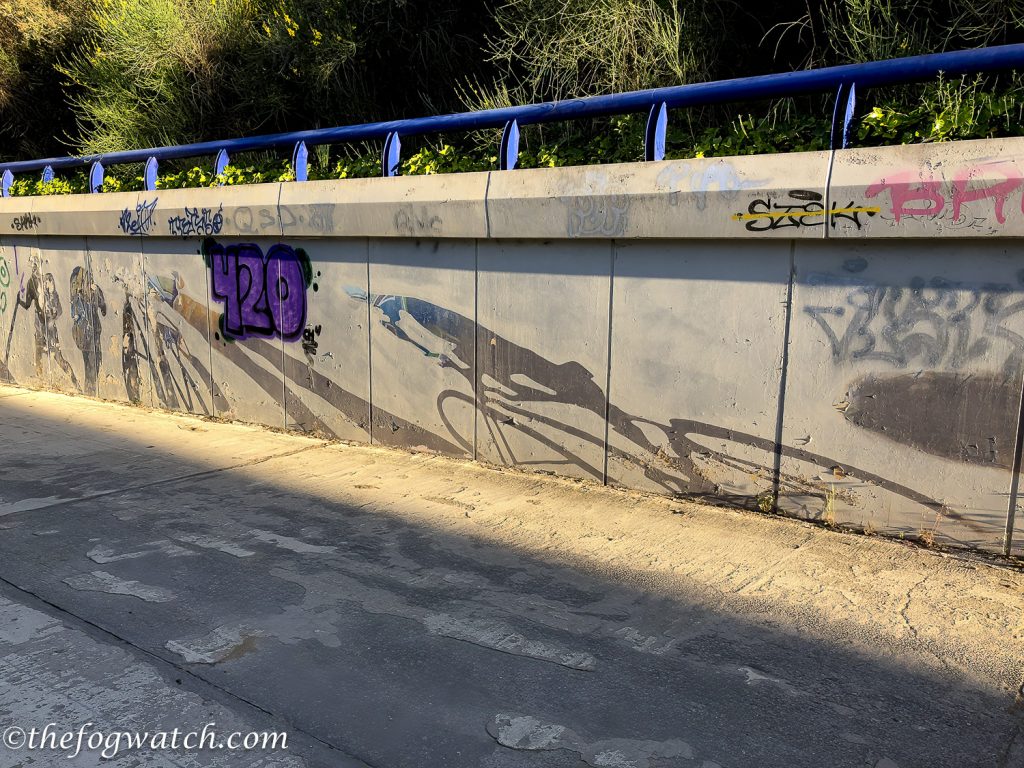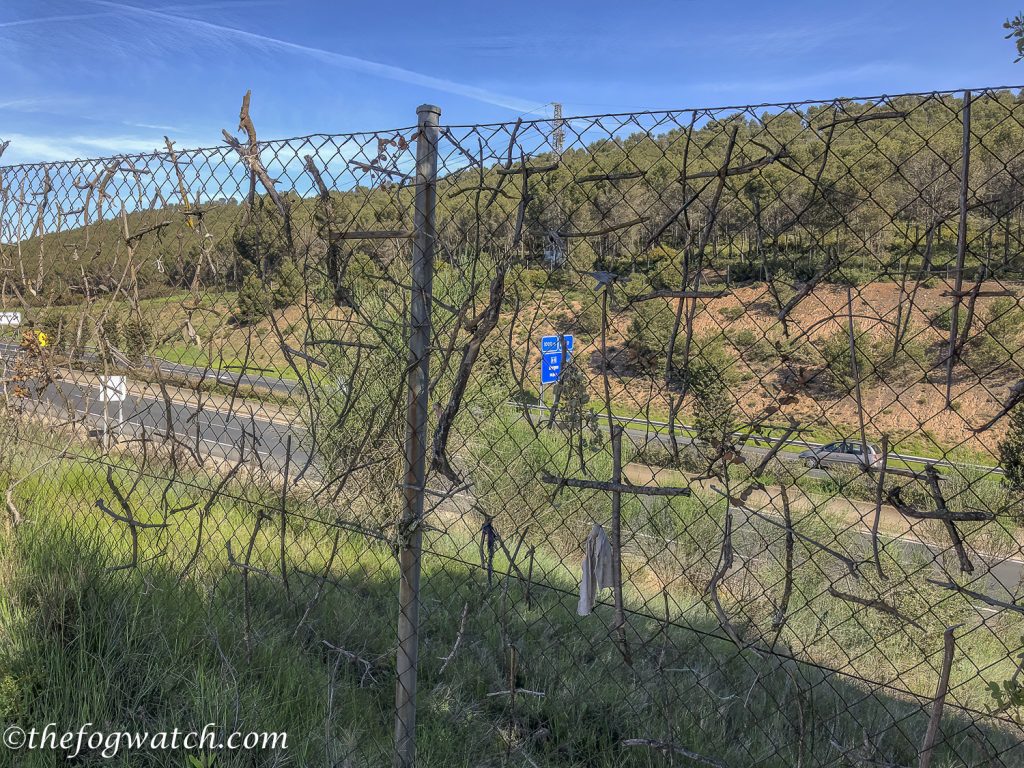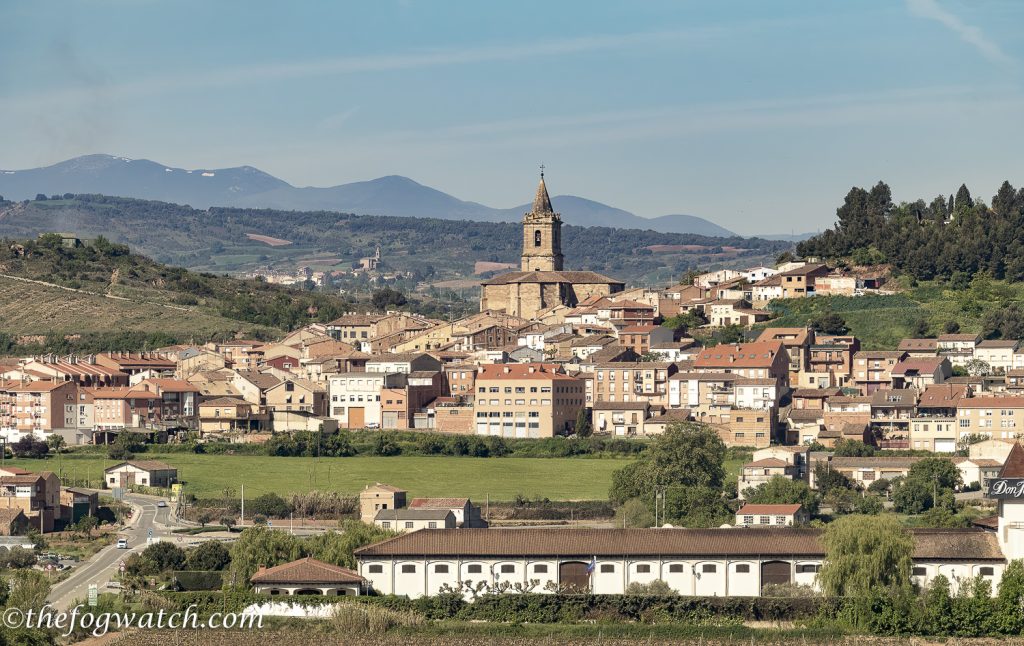The council has upgraded the path to Navarrete out of Logroño. I really liked the anamorphic shadows of pilgrims and cyclists painted on the walls of the underpass beneath the road.

We passed through the university grounds as we headed out from the city.
A shrine stood at the entrance to the park dedicated to the Virgin Mary. At first, I thought the two dark patches in the crown were her sunglasses, but no, her face was below the sun-like crown, and she cradled the infant Christ. The shrine reminded me of the strength of the Feminine Principle in pre-Christian religion. It comes from the pagan Roman tradition, before being incorporated into the Catholic tradition. I waited while a young woman made a short prayer before she moved off. Spain is a very religious country, and the Camino especially so. It is after all the reason for the Camino to exist in the first place.

And so we headed into La Grajera Park and past a large lake or reservoir built in 1883 over a natural lagoon, designed to irrigate the vegetable market gardens. The air smelt fresh and energised as we passed this body of water, and we relished the shade of the trees just ahead.
Today, flocks of water birds populate the lake. It is a bird sanctuary with signs to that effect — in case the birds didn’t realise that. The sky was clear and heading for a top of 27°C we appreciated the tree shade and the friendliness of the red squirrels with their tufted ears. The park extends to 427 hectares (just over 1000 acres). There is a rest area here with modern toilets — much appreciated! I watched a pair of large geese taking in the view over the lake from the shelter of the rest area. And I thought of the Game of the Goose — were they pointing the way to Santiago de Compostela? Geese are traditionally considered wise — perhaps because their Western migration path seems to indicate the path to Santiago.

It was good to see that Pilgrim Marcello still has his donativo fruit stand. We didn’t get a stamp there as he was busy with other pilgrims.
So we walked on and up the hill of Alto de la Grajera passing the hundreds of crosses handwoven into the fence from twigs lying around nearby, as they have been for many years, perhaps decades. Navarrete seemed still some distance away as we climbed.

As we crested the hill we saw the famous Bull sign. It’s apparently the logo of a Spanish Veterano brandy made by the Osborne Sherry Company. It seems that in 1956 they wanted to put up a large billboard, using a Bull icon and their brand, Osborne. With successive laws, the bull grew in stature, starting as a 4-metre high wooden sign. A metal sign replaced it in 1961 as the wood deteriorated with the weather. It also increased from 4 to 7m in the process.
Then a year later, in 1962, the Government passed a new law stating that advertising signs had to be 20m from Spanish roadways. So the company increased the size of the sign again, this time from 7 to 14 metres. In response, the Government passed a new law in 1974 requiring a further move to 50 metres from the road. A rise in accidents related to motorists’ inattention due to advertising signs led to a further law in 1988 prohibiting all advertising visible from the motorways and their surroundings.
But Spaniards can be assertive people, so Osborne, backed by protests from local citizens and intellectuals, took the matter to the Supreme Court. By now the logo was seen as part of the symbol of Spain itself. And it was now part of the landscape. Finally, in 1997, the company and government reached a compromise. They could keep the sign —if they dropped the brand name from the logo — leaving only the bull shape. By this time the bull was so associated with the brand that the lettering was unnecessary anyhow. Did you know that there are 92 such bull signs throughout Spain?
The town of Navarrete came into view as we crested the hill, dominated of course by the church, and like many of these towns, it was a key resting place for pilgrims on the Camino.

We descended once more and were guided onto a completely new path and road. This took us into Navarette across some roadworks installed since we last walked in 2018. As we entered Navarrete, we found the path to be no longer a dirt trail. There’s now a bridge over the swampy irrigation channel. But the path still intersects with the ruins of the ancient pilgrim hospital of San Anton de Acre.
The sound of frogs pierced the air. From the bridge I looked down to see if I could spot one of the noisy creatures. They seemed camouflaged until I used the zoom lens, honing in on the sound of one in particular. And there it was, a delightful green and yellow frog in shallow water on the mud.

The pilgrim hospital was established by Doña Maria Ramirez around 1285 to look after pilgrims on the road to Santiago. The entrance to the original hospital is now the entrance to the town cemetery at the other end of town. The church associated with the hospital was likely built by Bishop Martin, son of Doña Maria Ramirez. It was still standing until the end of the C19th when the council demolished it as it was no longer a safe structure.
That was when the Council removed the entrance to the complex and relocated it to the Navarette graveyard.
Adjacent to the ruins is a winery, the Bodega Don Jacobo. This winery still has the sign optimistically proclaiming that Santiago is now only 576km away. These are, of course Spanish kilometres! Perhaps the Way is shorter by the freeway? 🙂 It felt as though we had made encouraging progress — at least until we encountered an official sign telling us we had more than 600km still to go.

The Stoic philosopher Epictetus reminds us that some things are within our control (to keep walking or not), and some things are not in our control (the accuracy or truth of information from others about the actual distance remaining). And in the latter case, there are many variables, such as:
- the actual route taken — some roads are more direct than others,
- the type of measurement used — which can vary in accuracy, and
- the nature of the terrain — which can also affect the accuracy of instrumentation.
These are all external to ourselves, and outside of our control. So, while we may feel disappointed that the distance was further than we thought, we can easily banish that disappointment. We just need to recognise that the distance markers are at best a guide. But they are not always accurate. However, discrepancies exist, even among the official markers. It all depends on where you take the measurements from.
We entered the town having made good time and had lunch at Bocateria Nova next to the church. You can tell it’s an old town as the entrance floor to the Posada Ignatius is made from pebbles pounded into the ground. This is a key marker that it’s around C13th or C14th. But it does hurt your feet when changing out of your boots!
The parish church of the Assumption took nearly a century to build (1553-1645). Among the stonemasons was Juan Perez de Solarte who was the senior master stonemason of Burgos Cathedral. It’s interesting to find indications of these master craftsmen travelling along the Camino, adding their skills to parish churches along the way.
Fernando de la Peña built the altarpiece over four years 1694-98. José de San Juan Y Martin further renovated it in 1713. But it wasn’t to everyone’s taste.
In 1795, when Jovelanos visited, he described the church as:
“Frightening due to its height, width, poor sculpture, and the profusion of gold.” Today it is perhaps one of the most spectacular of all the Rioja Baroque style altarpieces. And I would definitely have to disagree with Jovelanos — I think it’s quite spectacular!
For me, the vaulting is amazing as well as the skill of the elaborate gilded carving of the retable or altarpiece.

There is a magnificent statue of St James the pilgrim dressed in a green tunic with gilded shells, along with the traditional staff and gourd.

We checked into Hostal Ciudad de Najera, showered, washed clothes, and found a cafe for dinner. And so to sleep.
To sum up, our walk from Logroño to Navarrete took us through a park where birds find sanctuary, past crosses and a bull with a history, then over frog-inhabited streams to a medieval pilgrim hospital amid misleading distance signs with a Stoic lesson about what is or is not in our control — with apologies to Epictetus 🙂
Let me know about your experiences of this section of the Camino in the comments section below 🙂











I am always amazed at the architecture of the early churches, especially the vaulted ceilings. I’m with you, the work is stunning.
Ann
Thanks Ann — Yes, what an amazing achievement for those early builders!
Wonderful Jerry.
When Shirley taught at the Laboral High School in Lardero (outskirts of Logroño) 2007/8, I would visit every month or so by driving from our home near Nantes, over the Pyrenees, through Pamplona then on via the new autovía to La Rioja.
If I left home at “sparrow’s” and went into Aussie Long-Reach driving mode, I could make it to Lardero by late arvo.
In the February, and in crisp air and bright winter sunshine, I walked this section. 2008 was a notable drought year, and the bird lake was rather low. There were quite a few peregrinos. When I looked up, there were geese and a giant Airbus 380 which had left a circular vapour trail and so may well have been on a test flight out of Toulouse.
I had lunch in the Rey Sancho, which had recently opened in response to the rising tide of caminantes. After dessert I fell into conversation with Alfredo, who owned a small pottery workshop at the top of Navarrete. He gave me a guided tour of the taller/workshop as the February sun faded. We still have the yellow earthenware tortilla plate he gave me as a gift before waving me off down the hill and a hitch-hiked ride back to Lardero.
2007 was also the year of our most recent return to Australia. We shall travel there next month to catch up with family and friends. We’d be delighted to see you for a chinwag if we end up in your part of the Wide Brown Land.
Thanks once again for transporting us back along El Camino.
Kind regards
Alan and Shirley
Thanks Alan and Shirley — Thanks for sharing your experiences in Logroño — I love that place! If you get to Canberra we’re always happy to meet other pilgrims or those like you who walk with the Camino mindset 🙂 At some point I hope to go back to Nantes – I love the Machines de l’isle there 🙂
Buen Camino!
I love the calmness, for me, of these series, especially in these difficult times. They’re an antidote to my own work, my own art and writing…
Love to all, Alan
Thanks Alan — the Camino brings calm to troubled souls — each one I’ve walked to date has brought the same sense of faith in humanity.